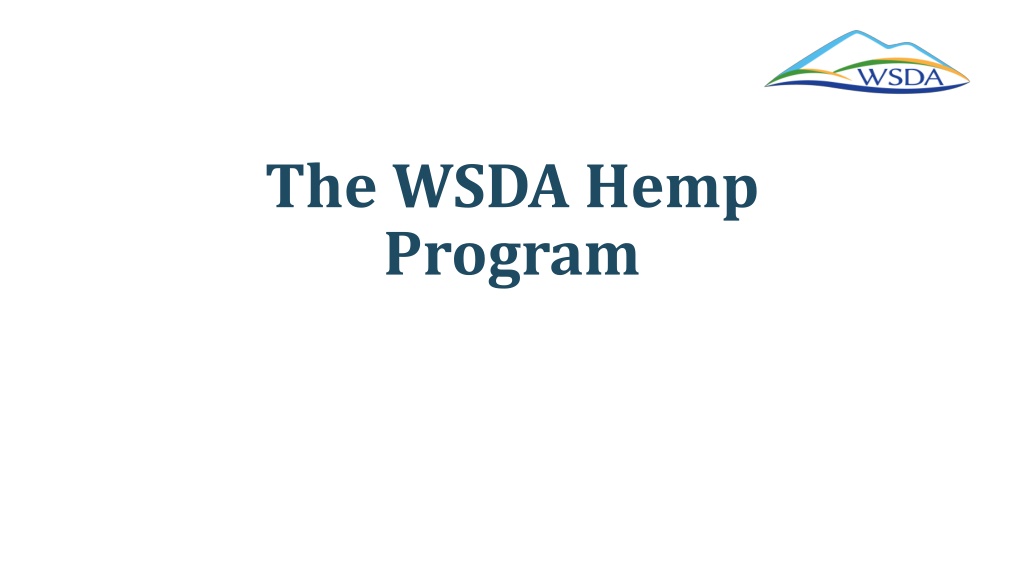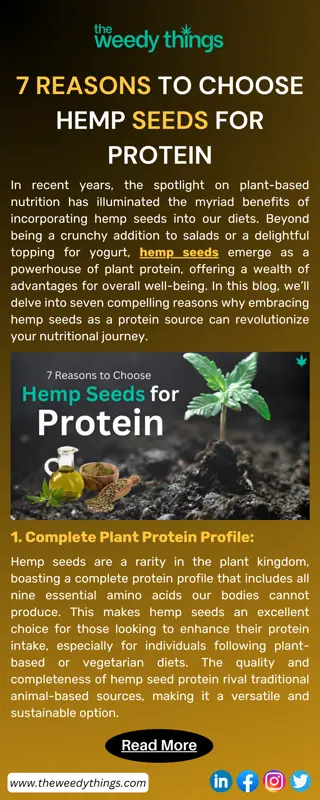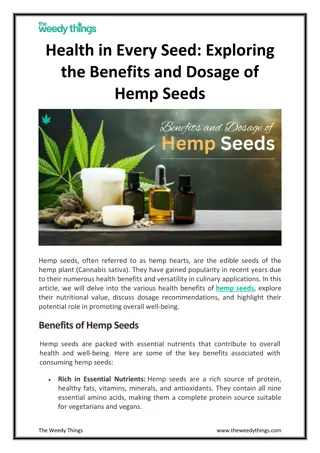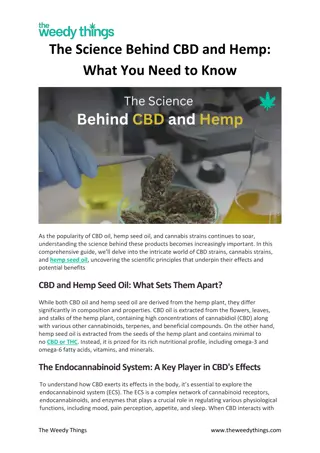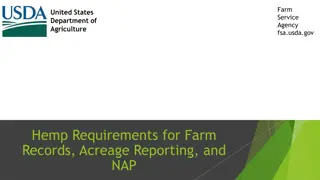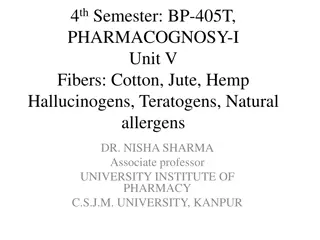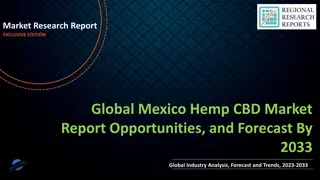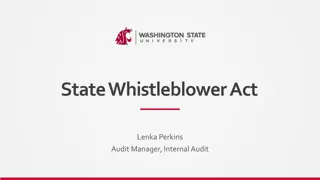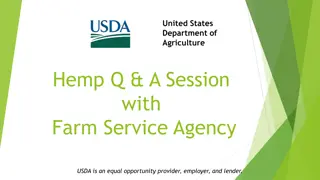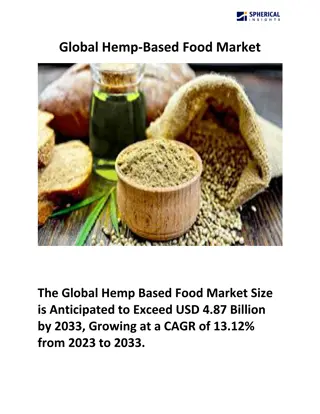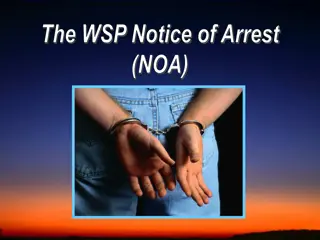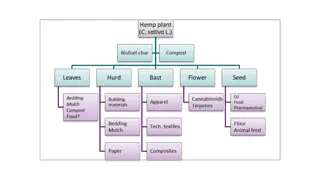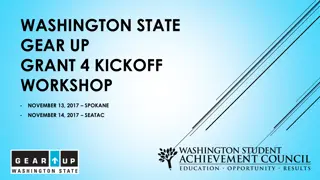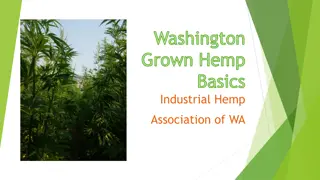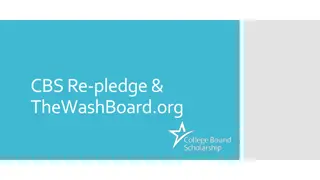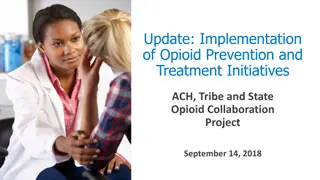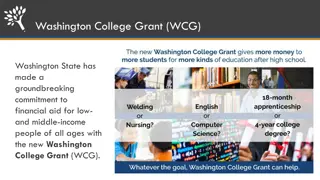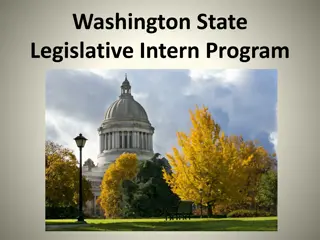Understanding the Washington State Hemp Program
The Washington State Hemp Program, initiated in 2014 as the Industrial Hemp Research Pilot Program, has evolved to facilitate commercial hemp production. Learn about the program's history, regulations, current status in 2021, and reasons why people are growing hemp in Washington State.
Uploaded on Feb 17, 2025 | 0 Views
Download Presentation

Please find below an Image/Link to download the presentation.
The content on the website is provided AS IS for your information and personal use only. It may not be sold, licensed, or shared on other websites without obtaining consent from the author.If you encounter any issues during the download, it is possible that the publisher has removed the file from their server.
You are allowed to download the files provided on this website for personal or commercial use, subject to the condition that they are used lawfully. All files are the property of their respective owners.
The content on the website is provided AS IS for your information and personal use only. It may not be sold, licensed, or shared on other websites without obtaining consent from the author.
E N D
Presentation Transcript
The WSDA Hemp Program
What is the hemp program? The Hemp Program started in 2014, as the Industrial Hemp Research Pilot Program , which was authorized by the 2014 farm bill, and allowed for hemp production solely for the purpose of research (not commerce.) In 2018, the Farm Bill removed Industrial Hemp from the Controlled Substances Act In 2019, the USDA established an interim final rule, followed by a Final Rule, that was published in 2021, and sets the stage for the commercial hemp program that we have today In 2021, we had approximately 115 growers producing hemp for a variety of commercial purposes throughout the state of Washington.
How WSDA got here 2014: Industrial Hemp Research Pilot Program launches. We had less than 10 research pilots under the program. December 2018 Farm Bill finalized; industry had to bring forward a bill creating a commercial hemp program in 2019. Industry and WSDA worked together to identify how the program could move forward right at descheduling this included limiting consumer consumption to hemp derivatives identified as GRAS by FDA (or within the I-502 system). Did not include processer regulation, only regulated the growing of the crop to the point of harvest. 2020: made some small updates to align the statute with the USDA requirements 2021: created a voluntary processer registration to meet specific state import requirements 2022: created a voluntary food safety-based hemp extract certification to meet certain state import requirements.
Hemp in 2022 The hemp program looks slightly smaller in 2022 than 2021, with about 70 licensees, though producers are still signing up. The largest concentration of farms in Washington is in the Yakima region, however there are farms everywhere from Spokane to the San Juan Islands. Most producers harvest between August 15 and November 15, however we have a small number of indoor and greenhouse producers that harvest throughout the year. Both the USDA and the WSDA have implemented new software programs, that allow us to easily report program data to the USDA on a monthly basis, as required.
Why are people growing hemp? People grow hemp for a variety of reasons, however the hemp market in Washington State is highly cannabinoid centric. Of about 70 or so growers 45 are producing for CBD or other cannabinoids and cannabinoid oils 33 are producing for smokable hemp 24 are producing for fiber 24 are producing for replication of seeds 18 are producing for transplants and clones 10 are producing for grain 13 are producing for Other this may include microgreen lettuces or other experimental uses.
How is hemp regulated by WSDA? All hemp producers must be licensed by the WSDA. Any crop that is harvested for commerce must be tested by a WSDA employee within 30 days prior to it s harvest. Crops must test below 0.3% THC to receive THC Certification, otherwise the crop must be remediated or disposed of using department approved methods. Once the hemp is harvested with a THC Certification or disposed, WSDA exits the regulatory process. Currently there is no regulatory framework for hemp products. There are two processer specific programs offered by WSDA voluntary processer registration and voluntary hemp extract certification
What is the future of hemp? Hemp has a lot of opportunity in a world that is responding to climate change and evolving supply chain dynamics. Hemp has a variety of great, environmentally friendly infrastructure uses: from flooring for houses, hemp crete for walls and other construction, and even for roofing material. Hemp can be used to make fabrics, ropes, and beyond. Hemp can also be used to produce grain for cereals, milks, and other agricultural uses.
Specific WSDA concerns around hemp derivatives Dosing information available is all specific to Epidiolex an FDA regulated seizure medication Lack of inclusion on the GRAS (generally recognized as safe) list means that normal toxicological information for hemp derived ingredients is not available State departments of agriculture and health do not normally conduct their own ingredient analysis and establish standards. We do not have that expertise. Available information is all over the map on this topic whether we are discussing cannabinoids only or other hemp derivatives as well
Questions needing answers Normal food ingredients are cleared by FDA. In the absence of that, what would the state choose to regulate right now? All hemp ingredients? Cannabinoids only? Specific low, medium or high risk final products or just derivatives? What is included in this regulation? Concentration (and who sets it)? Food manufacturing processes (GMP)? Labeling? Who regulates? (WSDA, DOH, LHJ)
